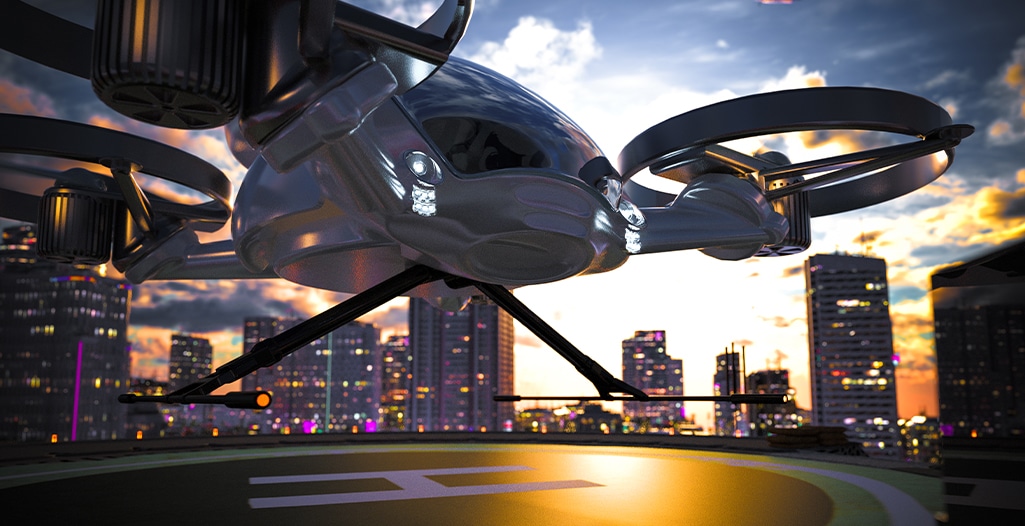Significant progress has been made towards realizing the ambitions of electric aviation pioneers. Aircraft have been built and tested, and regulators have been busy developing frameworks for aircraft and operational certification.
This is good news for original aircraft manufacturers (OEMs) who have invested billions in developing electric aircraft. According to one report*, the larger companies alone have issued individual statements that, taken together, suggest that a combined 26,000 electric vertical take-off and landing aircraft (eVTOLs) will be produced by 2030. That is a staggering number when considering that most eVTOLs are still in pre-production testing and when comparing it to the total number of commercial aircraft in service today worldwide.

At the annual Revolution.Aero Advanced Air Mobility (AAM) conference recently held in San Francisco, the majority of delegates (including many industry insiders) predicted that only a few thousand electric aircraft would be in service by 2030. That is likely a pessimistic prediction, especially when smaller cargo aircraft are factored into calculations.
Regardless of the actual numbers, what is clear is that if the OEMs’ goals are to be realized and the corresponding flight activity supported, many other pieces of the jigsaw puzzle must fall into place quickly.
1. Infrastructure
Primary among items required to support aircraft operations will be the physical and technological scaffolding to facilitate mass adoption. Vertiports will have to be built, charging facilities developed and airspace management solutions created. This is where the majority of non-aircraft-specific investment has been made. But, while some OEMs are invested in infrastructure, there is much still to be done.
2. Urban planning and outreach
For the physical infrastructure to be built, local communities and planning officials will need to be convinced of the benefits (and safety) of urban and suburban air services. While surveys suggest general support of urban air mobility (UAM), the potential reality of a vertiport in one’s own community might create a different response. Outreach and public relations will be key to widespread adoption.
3. Pilot hiring and training
Against a backdrop of a hiring strain in the aviation industry in general, operators must create a path to exciting, well-paid jobs for flight and ground crews. Exactly what experience will be required will be an interesting discussion to follow and will depend upon levels of flightdeck autonomy and ease of operation. Salaries and benefits will have to make sense, too, based on target flight costs.
4. Maintenance, repair and overhaul (MRO)
Reliability will be key to successful implementation of flight services. While many OEMs are creating vertically integrated operations, third-party MRO infrastructure will likely be required on some level. OEMs will need considerable local assistance if their spiderweb-like operational networks are to be supported.
5. Regulatory and operational approval
The regulatory aspect of this is self-explanatory. Nothing will happen until aviation authorities provide their approval. Operational approval, however, is worth highlighting. Significant flight testing, beyond just the aircraft certification, is likely going to be required before established air carriers adopt electric aircraft (or any new model) into their operations.
6. Safety, risk management and environmental readiness
This plays into every aspect of operational readiness. Safety and sustainability will be key to convincing regulators, local communities and insurers of the viability of the electrification and urbanization of air services. One aspect relates to batteries — not just in terms of safety and reliability, but their ability to be recycled and truly contribute to carbon-neutral transportation.
Risk will also play into insurability. While some companies, like Global Aerospace, have made a commitment to the AAM sector, the broader insurance community must be convinced of the safety and potential of electric air travel.
7. Financially backed orders and further investment
To bring all these supporting priorities to fruition, funding will be required that matches the investment that has, so far, been flowing into the aircraft. While some companies are working on solutions to infrastructure in particular, financing for support services within the broader eVTOL ecosystem has been significantly behind the investments made to build the vehicles.
By one estimate*, while some USD16 billion has been invested in aircraft development, only USD1.1 billion has been invested in other areas of the sector, with the majority going to airspace management solutions.
Furthermore, it is likely that for full production to be started, most companies will have to raise more money. This could come, at least in part, from leasing companies and operators backing up their letters of intent with paid deposits.
Collaboration and Cash
It took seven years for the Airbus A380 to enter service from its launch. While it created organizational challenges for airports (like double-level jet bridges), the jet was at least using traditional airports and fuel sources. Advanced Air Mobility aims to create an entirely new way of operating aircraft.
Significant investment in infrastructure and support functions, to mirror aircraft investment, will be needed to allow OEMs to reach their manufacturing potential and for the sector to meet its operational aspirations. Furthermore, many believe that for the eVTOL operating market to flourish, OEMs will have to work together to create an environment where vital infrastructure can be shared.
The work is just beginning and must progress steadily if the anticipated 26,000 aircraft in service by 2030 is to become a reality.
Resources
*Renaissance Strategic Advisors analysis